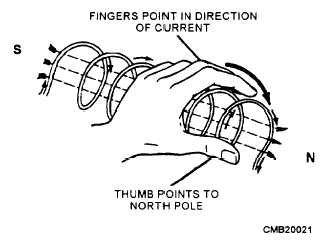type is known as an electromagnet or a solenoid. Electromagnets can be in many shapes. The field coils of generators and starters, the primary winding in an ignition coil, the coils in electric gauges, even the windings in a starter armature, can be considered to be electromagnets. All of these components produce magnetism by electrical means.
The North Pole of an electromagnet can be determined, if the direction of current flow (from negative to positive) is known, by use of the left-hand rule (fig. 1-21). The left hand is around the coil with the fingers pointing in the direction of current flow. The thumb will point to the North Pole of the electromagnet. This rule is based on current, or electron, flow from negative to positive.
The left-hand rule also can be used to determine the direction that the lines of force circle a wire- carrying current if the direction of current is known. This is done by circling the wire with the left hand with the thumb pointing in the direction of current flow (negative to positive). The fingers will then point in the direction that the magnetic field circles the wire.

Figure 1-21. - Left-hand rule.
The strength of an electromagnet can be increased greatly by wrapping the loops of wire around an iron core. The iron core passes the lines of force with much greater ease than air. This effect of permitting lines of force to pass through easily is called permeability. Wrought iron is 3,000 times more permeable than air. In other words, it allows 3,000 times as many lines of force to get through. With this great increase in the number of lines of force, the magnetic strength of the electromagnet is greatly increased, even though no more current flows through it. Practically all electromagnets use an iron core of some type.
ELECTROMAGNETIC INDUCTION
Current can be induced to flow in a conductor if it is moved through a magnetic field. In figure 1-22, the wire is moved downward through the magnetic field between the two magnetic poles. As it moves downward cutting lines of force, current is induced in it. The reason for this is that the line of force resists cutting and tends to wrap around the wire as shown. With lines of force wrapping around the wire, current is induced. The wire movement through the magnetic field produces a magnetic whirl around the wire, which pushes the electrons along the wire.
If the wire is held stationary and the magnetic field is moved, the effect is the same. All that is required is that there be relative movement between the conductor and the magnetic lines of force to produce enough voltage to move the electrons along the conductor.
Moving the magnet can move the magnetic field or, if it is a magnetic field from an electromagnet, starting and stopping the current flow in the electromagnet can move it. Suppose an electromagnet, such as the one shown in figure 1-20, has a wire held close to it. When the electromagnet is connected to a battery, current will start to flow through it. This current, as it starts to flow, builds up a magnetic field.

Figure 1-22. - Electromagnetic induction.
Continue Reading